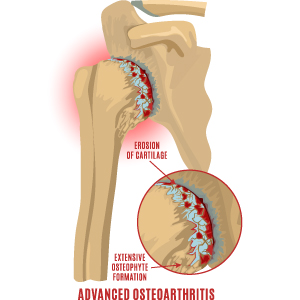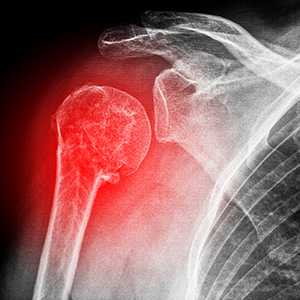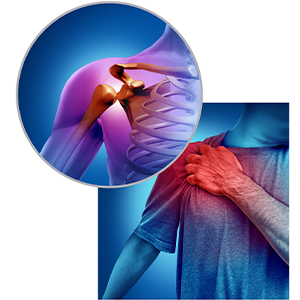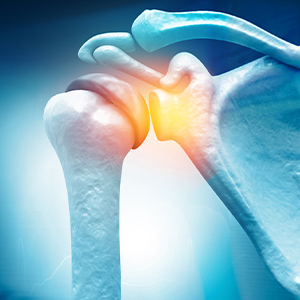5 Reasons Your Shoulder Hurts or Feels Weak

From everyday chores to hobbies and sports, we rely heavily on our shoulders. The most mobile joints in the body, shoulders give us the wide range of motion needed to perform tasks. Flexibility is their superpower. But this advantage also makes them vulnerable to injury.
“The shoulder is like a golf ball on a tee – it's great for range of motion, but you can develop problems if the ball starts to slide off the tee,” says Munson Orthopedic Institute's Matthew Dubiel, MD, a Mayo Clinic fellowship-trained orthopedic surgeon who specializes specifically in shoulder function and pain. He shares the most common shoulder injuries below.
Shoulder Arthritis

Starting as early as age 50, some people get osteoarthritis. This occurs as the smooth surfaces of the cartilage that line the bones of the shoulder joint are worn away, and joints start to wear out. Another type of arthritis is rheumatoid arthritis, an autoimmune disease that can damage your joint tissues.
Causes and Symptoms
While osteoarthritis is primarily caused by age, rheumatoid arthritis is a chronic inflammatory disorder that can attack your body in many ways, including the lining of your joints. Pain, swelling, grinding (or “clicking”), and limited movement are the most common symptoms of shoulder arthritis.
Treatment
- Rest
- Ice
- Medication (as prescribed by a provider)
- Consult an orthopedic expert
Shoulder Fracture

Unfortunately, shoulder fractures are very common. This area of the arm bone that sits close to the shoulder joint can weaken as we get older.
“If your shoulder fractures from a ground-level fall, we address the underlying problem of osteoporosis as well as the fracture,” Dr. Dubiel explains.
Causes and Symptoms
Upper arm fractures are commonly caused by falls, such as a simple fall to the ground. But for younger adults, this type of injury often occurs during a ski or car accident, Dr. Dubiel says.
Symptoms of a shoulder fracture can include bruising, swelling, inability to move the shoulder, and severe pain.
Treatment
- Sling
- Consult an orthopedic expert
- Surgery may be needed
“The three most common treatments for an upper arm fracture are non-operative treatment in a sling, surgical fixation with a plate and screws, or a shoulder replacement. We really have to look at the entire picture of the patient, their age, activity level, and fracture characteristics to help guide our decision-making,” Dr. Dubiel says.
Rotator Cuff Tear

The rotator cuff is a group of four muscles in the upper arm, attached to the bones by tendons. These tendons are what allow the muscles to raise and rotate your arm. If the tendons tear, your upper arm bone (humerus) can't move as easily in the shoulder socket. This makes it hard to move the arm up or away from the body.
Causes and Symptoms
Most rotator cuff injuries happen to middle-aged or older adults who already have shoulder problems. As people age and are less active, tendons start to degenerate and lose strength. This weakening can lead to a rotator cuff tear. An injury, infection, or certain types of diseases like diabetes can also lead to rotator cuff tears.
Because the shoulder has limited blood supply, it’s harder for the tendons to fix and maintain themselves. Symptoms of a torn rotator cuff can include:
- Tenderness and soreness in the shoulder
- Inability to raise your arm
- Difficulty sleeping on your side
Treatment
- Rest
- Ice
- Compression
- Elevation
- Physical therapy
- Medication (as prescribed by a provider)
- Surgery may be needed
Shoulder Instability (Sprains and Dislocations)

A shoulder sprain happens when the ligaments that hold the humeral head to the shoulder blade tear. If this happens, the collarbone is pushed out of place and may form a bump at the top of the shoulder. If the ligaments holding the shoulder bones tear and can't hold the joint together, the shoulder is dislocated.
Causes and Symptoms
Shoulder instability happens most often in young people and athletes. When the muscles and ligaments that hold it together are stretched beyond their normal limits, the shoulder becomes unstable. In athletes, shoulder instability is caused by certain motions used in tackling or pitching, for example. These motions put great force on the shoulder, stretching the shoulder ligaments over time. It can cause pain that comes on either quickly or gradually and a loose or weak-feeling shoulder.
Sprains also often occur during a fall, when your hand or arm is outstretched to stop the fall, or when you fall on a hard surface. Sprains can cause severe pain, a misshapen shoulder, and decreased shoulder movement.
Finally, falling onto an outstretched hand, arm, or the shoulder itself – or a violent twisting of the arm – can also cause a shoulder dislocation. The main symptom is pain in the shoulder that becomes worse with movement.
Treatment
- Dislocation
- Ice
- Go to urgent care
- Medication (as prescribed by a provider)
- Sprain
- Ice
- Physical therapy
- Medication (as prescribed by a provider)
- Surgery may be needed
Frozen Shoulder

This extreme stiffness in the shoulder can happen at any age. It affects about 1 in 50 Americans, most often between ages 40 and 60.
“Adhesive capsulitis – or frozen shoulder – is very common and can rear its ugly head in middle age,” Dr. Dubiel says. “It can be caused by both subtle and significant injuries that increase inflammation and stiffness in the shoulder joint.”
The causes of frozen shoulder are not fully understood. Frozen shoulder can affect people with diabetes, rheumatoid arthritis, thyroid disease, heart disease, or Parkinson’s disease. It can also happen if the shoulder has been immobile for a period of time or when a minor shoulder injury heals with scar tissue. The main symptoms include pain, stiffness, and limited movement.
Treatment
- Stretch before activities
- Physical therapy
- Medication (as prescribed by a provider)
- Consult an orthopedic expert
Consult the Experts

If your shoulder pain persists, you’re not sure what is causing your shoulder pain, or your current treatment plan is no longer working, maybe it’s time to see an orthopedic expert like Dr. Dubiel who specializes specifically in shoulders. Dr. Dubiel is now seeing patients in both Traverse City and Grayling.
At Munson Healthcare Orthopedic Institute (MOI), our fellowship-trained orthopods work with you to build a personalized treatment plan that pinpoints your shoulder (or other joint) pain. MOI prides itself on putting patients first – and that includes exploring surgical alternatives. If surgery is necessary, our experts are with you during your entire journey, including “prehab” and post-procedure therapy with our nationally recognized partners, Mary Free Bed at Munson Healthcare, to enhance your recovery.